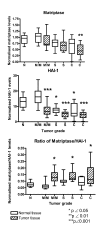The ratio of Matriptase/HAI-1 mRNA is higher in colorectal cancer adenomas and carcinomas than corresponding tissue from control individuals
- PMID: 16820046
- PMCID: PMC1525198
- DOI: 10.1186/1471-2407-6-176
The ratio of Matriptase/HAI-1 mRNA is higher in colorectal cancer adenomas and carcinomas than corresponding tissue from control individuals
Abstract
Background: It has recently been shown that overexpression of the serine protease, matriptase, in transgenic mice causes a dramatically increased frequency of carcinoma formation. Overexpression of HAI-1 and matriptase together changed the frequency of carcinoma formation to normal. This suggests that the ratio of matriptase to HAI-1 influences the malignant progression. The aim of this study has been to determine the ratio of matriptase to HAI-1 mRNA expression in affected and normal tissue from individuals with colorectal cancer adenomas and carcinomas as well as in healthy individuals, in order to determine at which stages a dysregulated ratio of matriptase/HAI-1 mRNA is present during carcinogenesis.
Methods: Using quantitative RT-PCR, we have determined the mRNA levels for matriptase and HAI-1 in colorectal cancer tissue (n = 9), severe dysplasia (n = 15), mild/moderate dysplasia (n = 21) and in normal tissue from the same individuals. In addition, corresponding tissue was examined from healthy volunteers (n = 10). Matriptase and HAI-1 mRNA levels were normalized to beta-actin.
Results: Matriptase mRNA level was lower in carcinomas compared to normal tissue from healthy individuals (p < 0.01). In accordance with this, the matriptase mRNA level was also lower in adenomas/carcinomas combined as compared to their adjacent normal tissue (p < 0.01). HAI-1 mRNA levels in both normal and affected tissue from individuals with severe dysplasia or carcinomas and in affected tissue with mild/moderate dysplasia were all significantly lower than mRNA levels observed in corresponding tissue from healthy control individuals. HAI-1 mRNA was lower in carcinomas as compared to normal tissue from healthy individuals (p < 0.001). HAI-1 mRNA levels were significantly lower in tissue displaying mild/moderate (p < 0.001) and severe (p < 0.01) dysplasia compared to normal tissue from the same patients. Both adenomas and carcinomas displayed a significantly different matriptase/HAI-1 mRNA ratio than corresponding normal tissue from healthy control individuals (p < 0.05). In addition statistically significant difference (p < 0.001) could be observed between mild/moderate and severe adenomas and their adjacent normal tissue.
Conclusion: Our results show that dysregulation of the matriptase/HAI-1 mRNA ratio occurs early during carcinogenesis. Future studies are required to clarify whether the dysregulated matriptase/HAI-1 ratio was causing the malignant progression or is a consequence of the same.
Figures

Similar articles
-
Expression of prostasin and its inhibitors during colorectal cancer carcinogenesis.BMC Cancer. 2009 Jun 25;9:201. doi: 10.1186/1471-2407-9-201. BMC Cancer. 2009. PMID: 19555470 Free PMC article.
-
Expression of serine protease SNC19/matriptase and its inhibitor hepatocyte growth factor activator inhibitor type 1 in normal and malignant tissues of gastrointestinal tract.World J Gastroenterol. 2005 Oct 21;11(39):6202-7. doi: 10.3748/wjg.v11.i39.6202. World J Gastroenterol. 2005. PMID: 16273651 Free PMC article.
-
Matriptase and HAI-1 are expressed by normal and malignant epithelial cells in vitro and in vivo.Am J Pathol. 2001 Apr;158(4):1301-11. doi: 10.1016/S0002-9440(10)64081-3. Am J Pathol. 2001. PMID: 11290548 Free PMC article.
-
Zymogen activation, inhibition, and ectodomain shedding of matriptase.Front Biosci. 2008 Jan 1;13:621-35. doi: 10.2741/2707. Front Biosci. 2008. PMID: 17981575 Review.
-
Role of the polycystic kidney disease domain in matriptase chaperone activity and localization of hepatocyte growth factor activator inhibitor-1.FEBS J. 2022 Jun;289(12):3422-3439. doi: 10.1111/febs.16348. Epub 2022 Jan 23. FEBS J. 2022. PMID: 35020274 Review.
Cited by
-
Intestinal regulation of suppression of tumorigenicity 14 (ST14) and serine peptidase inhibitor, Kunitz type -1 (SPINT1) by transcription factor CDX2.Sci Rep. 2018 Aug 7;8(1):11813. doi: 10.1038/s41598-018-30216-z. Sci Rep. 2018. PMID: 30087389 Free PMC article.
-
Loss of hepatocyte growth factor activator inhibitor type 1 participates in metastatic spreading of human pancreatic cancer cells in a mouse orthotopic transplantation model.Cancer Sci. 2014 Jan;105(1):44-51. doi: 10.1111/cas.12306. Epub 2013 Nov 25. Cancer Sci. 2014. PMID: 24147538 Free PMC article.
-
Relative expression of KLK5 to LEKTI is associated with aggressiveness of oral squamous cell carcinoma.Transl Oncol. 2021 Jan;14(1):100970. doi: 10.1016/j.tranon.2020.100970. Epub 2020 Nov 28. Transl Oncol. 2021. PMID: 33260070 Free PMC article.
-
Impact of suppression of tumorigenicity 14 (ST14)/serine protease 14 (Prss14) expression analysis on the prognosis and management of estrogen receptor negative breast cancer.Oncotarget. 2016 Jun 7;7(23):34643-63. doi: 10.18632/oncotarget.9155. Oncotarget. 2016. PMID: 27167193 Free PMC article.
-
High ABCC2 and low ABCG2 gene expression are early events in the colorectal adenoma-carcinoma sequence.PLoS One. 2015 Mar 20;10(3):e0119255. doi: 10.1371/journal.pone.0119255. eCollection 2015. PLoS One. 2015. PMID: 25793771 Free PMC article.
References
-
- Kim MG, Chen C, Lyu MS, Cho EG, Park D, Kozak C, Schwartz RH. Cloning and chromosomal mapping of a gene isolated from thymic stromal cells encoding a new mouse type II membrane serine protease, epithin, containing four LDL receptor modules and two CUB domains. Immunogenetics. 1999;49:420–428. doi: 10.1007/s002510050515. - DOI - PubMed
-
- Takeuchi T, Shuman MA, Craik CS. Reverse biochemistry: use of macromolecular protease inhibitors to dissect complex biological processes and identify a membrane-type serine protease in epithelial cancer and normal tissue. Proc Natl Acad Sci U S A. 1999;96:11054–11061. doi: 10.1073/pnas.96.20.11054. - DOI - PMC - PubMed
Publication types
MeSH terms
Substances
LinkOut - more resources
Full Text Sources
Other Literature Sources
Medical
Miscellaneous

